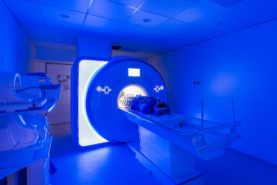 The progress of interventional radiology over the last twenty years has made it a significant alternative to surgical treatment.
The progress of interventional radiology over the last twenty years has made it a significant alternative to surgical treatment.
In the majority of cases, interventional radiological treatment involves a shorter stay in hospital without the need for a general anaesthetic. It also implies less risk, less pain and a shorter convalescence when compared to traditional surgery.
Interventional radiology is a subspeciality of radiology which employs imaging techniques to perform minimally invasive procedures. The aim of some of these procedures is simply to reach a diagnosis (e.g. angiography), whilst others form part of specific treatment (e.g. angioplasty).
Imaging is used in targeted radiological procedures which usually require needles, guides or catheters. The images act as a guide, enabling the radiologist to pass instruments through the body to the selected area. This not only reduces the patient’s physical trauma, it also reduces infection rates, recovery times and leads to a shorter stay in hospital afterwards.
Radiation exposure is a common concern amongst patients undergoing interventional radiological procedures. Interventionists, like radiologists, utilise techniques to reduce radiation to the minimum required for each procedure.
The latest equipment, such as that installed at HC Marbella’s Diagnostic Imaging Centre, takes advantage of digital systems to calculate the radiation dose, automatically controlling the level of radiation exposure. Those patients who may have particular radiation-exposure risks, such as during pregnancy, or in procedures which are more complex or extensive, receive clear, specific information regarding the risks and probable benefits of the intervention.
Some examples from the range of procedures possible include:
• Arteriography or angiography: vascular mapping to detect lesions and determine their size.
• Angioplasty, thrombolysis and insertion of endovascular implants: treatment of obstructive lesions using medication and catheters as well as other associated instruments, dilating or clearing blocked arteries.
• Endovascular implants have replaced several surgical procedures. They can be sited in several arteries including the carotid arteries, the main source of supply to the brain, to prevent cerebral emboli or haemorrhage.
• The rupture of abdominal aortic aneurysms is associated with high mortality. As an alternative to high-risk surgical procedures, interventional radiological techniques can be employed to insert implants, enabling reconstruction of the largest artery of the body and preventing rupture.
• Embolisation: the intentional occlusion of blood vessels is used in some cancer cases to decrease blood supply to the tumour. This type of treatment involves the injection of medication capable of controlling the growth of malignant tumours. Embolisation can also be performed to control haemorrhage and block aneurysms. Uterine myomas and other benign lesions can also be treated this way, a catheter is advanced through a small skin incision, via which substances are injected to eradicate lesions.
• Abscess drainage: insertion of a catheter through the skin, which is used to drain abdominal and other abscesses, these would otherwise require surgical intervention.
• Biliary drainage: alleviation of bile duct obstruction caused by benign or malignant processes, with reconstruction of the bile ducts in some cases. Extraction of calculi and treatment of malignant liver lesions is also possible via the biliary tract.
• Similarly, catheters can be advanced into the urinary system through percutaneous nephrostomy, to alleviate obstruction caused by calculi or tumours. Medication can also be injected directly into the arteries supplying renal tumours, to control cancer.
• Vertebroplasty: injection of cement into the vertebrae in spinal lesions (such as crushed vertebrae due to osteoporosis) can stabilise fractures and control the pain they cause. Other treatments employed for pain control in the spine include spinal blocks (image-guided injection of analgesia and anti-inflammatory medication) to the specific point causing the pain.
• For the diagnosis of tumours, or other lesions in any organ, a needle can be introduced to obtain a targeted specimen or biopsy, without the risks associated with obtaining tissue specimens during surgery.
• In some cases, the patient’s illness requires the administration of a particular medication through a central line, due to its closeness to the heart. Central lines can also be required for use as dialysis catheters or to measure the pressure within the heart chambers. Venous access can be achieved safely and effectively.
• In some cases of venous thrombosis, the migration of clots from the legs to the pulmonary circulation, where they can have serious consequences, can be prevented with the implantation of vena cava filters. These filters can be either permanent or removable, depending on each patient’s requirements.
Before undergoing a surgical procedure, ask your doctor if there is an interventional radiology alternative which could help in your case. Procedures may exist which could provide you with a diagnosis, or less invasive treatment.
Sources: CIRSE: Cardiovascular and Interventional Radiological Society of Europe; SERVEI: Spanish Society of Vascular and Interventional Radiology.
May 26, 2019
Read other news
Online appointment and download of test results through My HC.
Tel.: +34 952 908 628
952908898 Oncology
951829978 Diagnosis by imaging
951829947 Gynecology
952908897 Fertility
951829947 Physiotherapy